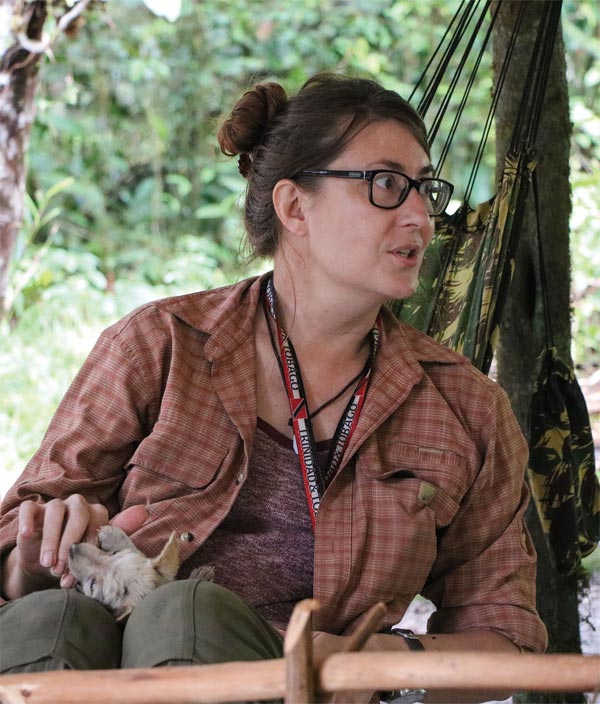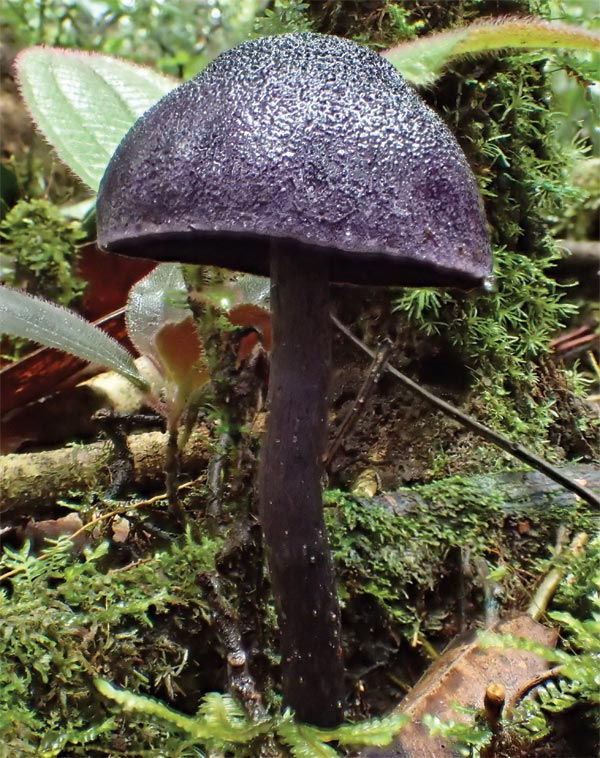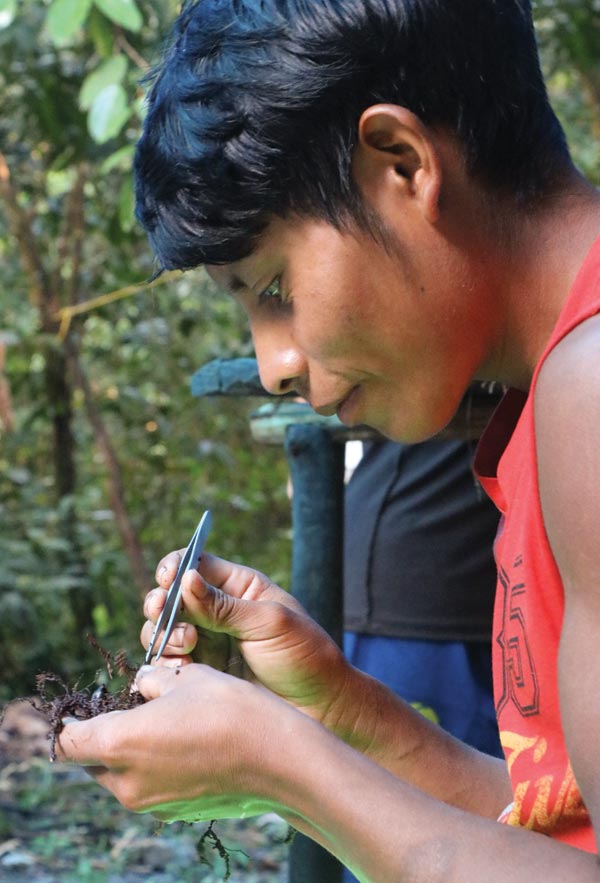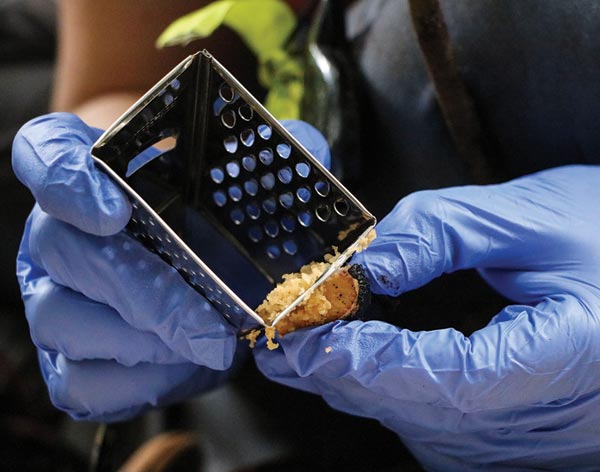Fungi Hunters Uncover Hidden Worlds
The Islander pitches in the headwinds as gauzy clouds spatter the windshield. Below, the plane’s shadow ripples over dense tracts of canopy broken only by dark rivers snaking toward the horizon and the occasional mine, bright gashes on the landscape. A placard in the cockpit reads “No flips, spins or acrobatic maneuvers permitted.” But landing on a jungle airstrip—just a streak of red dirt on a hillside—is quite an aerial feat in itself. A slick patch can send the plane reeling into the rainforest that flanks the strip, but with some rib-rattling jolts and a screech of metal on metal, we are suddenly on the ground in the Pakaraima Mountains of western Guyana.
The researchers tumble out: Catherine Aime, professor of botany and plant pathology; her doctoral student Rachel Koch; and Terry Henkel, a professor of botany at Humboldt State University. Everyone hustles to unload the gear from the cargo hold so the pilot can be on his way before the weather changes. Fifteen Patamona, Amerindians who have worked with Aime and Henkel in this region for nearly two decades, wade out of the bushes to lend a hand. It’s been a year since the last expedition, and handshakes and hugs are exchanged all around.
The team hauls buckets of provisions into the forest and prepares to hike further into the interior to an open-air research camp next to the blackwater Potaro River. In this makeshift home, army ants scurry below the hammocks at night, bees clean the sugar spoon in the morning, scorpions shelter inside shoes left out to dry, and drifts of mold thicken on backpacks. And with the Patamona as research partners, Aime and Henkel’s team pursues the undiscovered fungi of Guyana.
the takeaway
- Guyana, in the northeastern corner of South America, hosts some of the world’s last remaining virgin tropical rainforests. There, in the upper Potaro Basin of western Guyana near Mount Ayanganna, Professor Cathie Aime and her colleagues hunt for undiscovered fungi.
- 140 new species - The team has racked up descriptions of about 140 new species of mushrooms and eight new genera so far. Discovering a new genus is a rare event in biology.
- Aime and Henkel earned a National Science Foundation grant to study the symbiosis between fungi and the trees that dominate the forests they study.
- Fungi help provide clean air, clean water, and nutrition for plants, but much less is known about the estimated 3 million to 5 million fungal species than about the animal and plant kingdoms.
- Aime coauthored a recent study published in Science, announcing that lichens, thought to be a symbiosis between an algae and fungus, include a third partner: a previously undescribed yeast. This discovery was covered in National Geographic, Scientific American, The Atlantic, The New York Times, and The Washington Post.
Slow-burn treasure hunt
Little is known about the biology and ecology of Guyana, a small nation on the northeastern corner of South America that hosts some of the world’s last remaining virgin rainforests.
The vast majority of the country’s 800,000 inhabitants lives along the coast, and few Guyanese travel into the interior, largely unpopulated except for gold, diamond, and bauxite miners; a few villages; and Amerindian tribes. The tropics in general are significantly understudied compared with temperate regions, but Guyana is unexplored even by these standards. The interior is difficult and dangerous to traverse, and until the last few decades, the country was relatively closed to non- Guyanese scientists.

Catherine Aime, professor of botany and plant pathology
For the past 17 years, Aime and Henkel have methodically combed through a six-hectare research plot—roughly 15 acres—in the upper Potaro Basin near Mount Ayanganna, the country’s tallest standalone peak.
The project began as an all-you-can-pick mushroom foray, “just to start slapping some names on these things,” Aime says. Studies of fungal biodiversity led to detailed investigations of certain species, such as a black, mottled gasteromycete that is Koch’s focus. The team also explores broader ecological questions such as how fungi and trees interact to shape surrounding plant communities.
“There are parts of the world that we essentially know absolutely nothing about,” Henkel says. “In this region of the Guiana Shield, we have very little understanding of the biodiversity, and when you start focusing on fungi, the frontier of the unknown gets even more extreme.”
The plot continues to churn out surprises. The team has published descriptions of about 140 new species of mushrooms and eight new genera so far. A new genus is a rare discovery in biology.
All five senses
Aime crouches to the forest floor and jimmies a delicate brown mushroom from a crevice in a rotting log. She flattens her palm and examines the mushroom with her hand lens, the glass fogging with humidity.
She holds the mushroom up to a nostril. Then breaking off a piece of the stipe, or stalk, she chews it and spits it out. “Huh. Cinnamon.”
Old-school mycologists use all five senses to describe a fungus. Some species smell of chlorine. Others taste like hot peppers. Still others emit a foul odor to attract flies. All these details help identify a mushroom or draw up a description of a new species.
Aime straightens, and the group resumes its just-under-a-jog pace on the trail.
For a newcomer, the first task in the bush is learning how to walk. The forest floor is a ropey carpet of twisted, intertwined roots, smooth and wet. Navigating it is like getting your sea legs—each step on a different gradient than the next, the terrain constantly rollicking beneath you. Enormous fallen trees span the trail, and hugging the edges of hills are thick springy mats of roots and humus that sag as you clamber across.
Spectacular wipeouts happen. Aime and Henkel recount legendary falls, a precious mushroom specimen held miraculously aloft as they plowed into roots and mud.
From one trip to partnership
Their collaboration began in graduate school—Aime a doctoral student in mycology, the study of fungi, at Virginia Tech, and Henkel pursuing a botany PhD at Duke. Intrigued by a talk Henkel gave on his work in Guyana, Aime asked if she could hitch along on the next expedition.
 They teamed up on a trip in 2000, which “was supposed to be a one-time thing,” Aime said. “But we kept finding extraordinarily weird forms of fungi that didn’t fit the template taxonomy of temperate species. The first few years were full of wildly wrong guesses. We had to do a lot of detective work.”
They teamed up on a trip in 2000, which “was supposed to be a one-time thing,” Aime said. “But we kept finding extraordinarily weird forms of fungi that didn’t fit the template taxonomy of temperate species. The first few years were full of wildly wrong guesses. We had to do a lot of detective work.”
Guyana’s rugged wilderness replete with fungi that defied mycology textbooks proved irresistible. Aime and Henkel found green, stumpy mushrooms with shaggy, yellow hairs; a foot-tall, violet fungus; orange coral-like mushrooms with white tips; fragile ones shaped like tiny white parasols; mushrooms black and tough as BBs; fungi with pinkish-purple gills that stain an inky indigo; and a gray, stick-like species with a stunted, powdery cap that was later deemed the “mycological find of the century.”
The never-ending succession of discoveries and the knowledge that they can stumble on a new species on the way to the pit toilet keeps them coming back, cobbling together a shoestring budget and the summer weeks between university semesters.
“I’ll be out here until my legs give out,” Aime says.
Rainforest Researchers
Fungal-fueled super-trees
This year, Aime and Henkel landed a grant from the National Science Foundation to establish a new study in Cameroon based on the same laborious plot-based approach they use in Guyana. Those data will be used to compare the relationship between fungi and the massive Dicymbe corymbosa trees of the Guyanese forests with similar ecosystems in the Congo Basin.

Members of the research team gather high above the rainforest floor in one of the Paluway trees that dominates this ecosystem.
A member of the bean family, D. corymbosa, or “Paluway” in Patamona, is a megalith that rules this ecosystem, shading out smaller plants and creating cathedral-like structures, dark and eerily quiet. Sixty to 70 percent of the canopy trees here are Paluways, as are the majority of saplings and seedlings. This is one of a handful of tropical forests in the Americas dominated by a single species. Tough, shade-tolerant, and structurally stable, even if a Paluway falls, its stems can survive, take root, and regenerate.
“They’re oddballs, super-trees,” Henkel says. “They have evolved a whole package of life-history characteristics to maintain persistent dominance. We estimate some of these trees to be maybe a thousand years old.”
Aime and Henkel hypothesize that the key to the Paluways’ undisputed reign lies in their roots, which are coated with fungi known as ectomycorrhizae. These fungi have worked out a mutually beneficial bartering system with their tree hosts, trading carbon, nitrogen, and mineral nutrients from the soil in exchange for sugars, which helps their hosts stay fed and healthy.
Paluways are more closely related to other ecosystem- dominating tropical trees in the Congo Basin than they are to trees in their own region, suggesting that these trees were perhaps neighbors in Gondwanaland, the ancient supercontinent that broke apart 100 million years ago.
A field ripe for exploration
About 90 percent of plant species form symbiotic relationships with fungi, one of the many ecological services that fungi provide. They’re master recyclers as well, decomposing leaf litter and dead material, and are the only organisms that can break down lignin, the substance that lends wood its strength.
“It’s extremely important to know what you coexist with on this planet and what provides all the services: clean air, clean water, soils, and subsistence for plants,” Aime says. “To overlook fungi would be doing a grievous disservice to understanding the way the planet works.”
Yet little is known about fungi in comparison with other kingdoms, such as animals or plants. Scientists aren’t sure how many species of fungi exist, but estimates hover between 3 million and 5 million. Compare that with an estimated 400,000 plant species and 950,000 species of insects.
“If you pick up a fungus in a place where no one has been, there’s a good chance you’re holding a new species,” says PhD student Koch. “If you’re a biologist with an exploratory spirit, mycology will keep you busy for a lifetime.”
Not all fungi produce mushrooms. While the fungus is a microscopic organism that lies hidden beneath the ground or in rotting bark, mushrooms are like its flowers or fruit. They’re sexual organs, which is why they are so ephemeral. They appear when conditions are good for reproduction, disperse their spores, and quickly disintegrate.
This is what can make mushroom hunting both thrilling and frustrating. Below the soil surface are hoards of fungi, but until they produce a mushroom, they remain invisible. And the mushroom that shoots up after a night’s thundering rain could be shriveled by the afternoon. The researchers and Patamona keep a vigilant look-out for mushrooms as they hike and gather Paluway root tips, building collections to be housed at the University of Guyana and the Arthur and Kriebel Herbaria at Purdue, among others.
Guides and collaborators

Nathaniel Joseph, a Patamona member of the research team, teases out Paluway root tips that have been colonized by fungi.
Aime and Henkel’s research would not be possible without the Patamona, whose skills as guides and collaborators are essential to the project’s success. Each can build a shelter, bushwhack a trail, start a fire, hunt, fish, cook, weave baskets and backpacks, and identify edible and poisonous animals and plants.
“If you pick up a fungus in a place where no one has been, there’s a good chance you’re holding a new species.” —Rachel Koch
“This is remote backcountry,” Henkel says. “We don’t have any infrastructure, biological stations, or road access—it’s all wilderness. Without the Patamona, we’d be lucky to come out of an expedition alive.”
The Patamona also bring a wealth of biological and ecological knowledge to the team—expertise gained from a lifetime in this landscape. They can recognize hundreds of its species, their characteristics, and potential uses and keep a mental map of spots where valuable fungal specimens have been found in past years.
“They become trained taxonomists for a lot of these mushroom taxa,” Aime says. “If there’s something specific you’re looking for, they have the best eyes in the world to find it. And as the years go by, they become your second family.”
Punk rocker turned fungal trailblazer
Aime inherited the explorer’s gene from her father, with whom she spent many childhood hours scheming of ways to cross the Darien Gap, the notoriously treacherous land bridge that joins South and Central America. Her father dreamed of being a member of the exclusive Explorers Club—Aime is one.
“I was the geek who collected 200 fungal specimens when the assignment only called for 20.” —Cathie Aime
Fittingly, her route into mycology was circuitous and unconventional. A college dropout, she played bass in D.C. punk bands for a decade, earning the nickname “Cathie Aime-less” from her pals for habitually quitting waitressing gigs to travel. When she went back to school, she felt out of place as a thirty-something undergrad until she took a mycology course with Virginia Tech’s Orson Miller. Something resonated. “I was the geek who collected 200 fungal specimens when the assignment only called for 20,” she says.
Miller, who literally wrote the book on North American mushrooms, noted Aime’s enthusiasm and encouraged her to enroll in graduate school, becoming her PhD advisor and guiding her into the field that would become her profession. Aime can’t keep off the trail for long. What appeals to her about tropical mycology is that it’s a frontier within a frontier, and science in the bush requires ingenuity and foresight.

Graduate student Rachel Koch uses a sterilized cheese grater to scrape mushroom tissue for testing back in the United States.
“Forget something out here, and you’re doomed,” she says. “Like the time I brushed my teeth with soap for a month.”
In addition, the research methods must be jerry-rigged for the lack of electricity, refrigeration, and sterile hoods and the strict weight limits of flying into the interior. Everything is lightweight and miniaturized, and some of the equipment is unexpected.
After Koch’s gasteromycete tissue samples arrived in the States in unsalvageable condition last year, she and Aime came up with a new tactic: tiny sterilized cheese graters with which to scrape tissue from her mushrooms. If the graters don’t work, she’ll have to wait a year to try something new.
Love the questions
Aime peers into her microscope and tweezes off a root tip from the jumble in her petri dish. “That’s a weird one.”
Koch leans over to take a look. “Yeah, that one’s wild.”
They’re cleaning Paluway roots, collecting ectomycorrhizal fungi to genetically sequence back in the States.
A month later, in July 2016, a study Aime co-authored will hit the cover of Science magazine and shake up the science scene by announcing that lichens, the models of symbiosis, are actually threesomes. A third hidden partner, an undescribed yeast, joins an algae and fungus to make a lichen. National Geographic, Scientific American, The Atlantic, and The New York Times will fizz with nerdy lichen exuberance. Aime will be quoted in The Washington Post: “This is an excellent example of how things can be hidden right under our eyes and why it is crucial that we keep studying the microbial world.”
She will also win the 2017 Purdue Agricultural Research Award—the highest honor given to mid-career faculty members for excellence in applying scientific principles to solve important research problems.
But at this moment, she is rubbing her eyes, rolling her head, and blinking into the scope to pinch off the next fungus-covered root tip on her way to 100. This is what science looks like most of the time. Hours of meticulous benchwork might earn you a gold nugget of a discovery down the road—and might not. It’s more important to fall in love with asking the questions than the answers, Aime says.
The work the team does in Guyana is basic science, the curiosity-driven research that often succeeds in generating more mysteries than answers. That’s what it is supposed to do. Basic science can be tough to justify in a solutions-driven culture, because what it produces is not easily measured or quantified. Why do it?
The question elicits simultaneous groans from Aime and Koch because it’s both familiar and a hard one to field. Aime leans back from the scope and looks out to the river churning beyond the trees. “Don’t you want to know anything about the world we live in?”
Out to sea, to the moon, up Everest, down the Amazon, over a hillside, into a mushroom or a fungal spore, exploring the DNA that makes it what it is. If you have felt the pull of the unknown, then you understand a band of researchers tucked into hammocks draped with mosquito nets, scratching their chigger bites as rain thrums on the tarp, who tomorrow will climb a hill to fill tackle boxes with mushrooms that nobody has a name for. What they do adds, piece by piece, to what we know about the world.
Photos provided by Natalie van Hoose. Video by Steve Doyle and Natalie van Hoose.